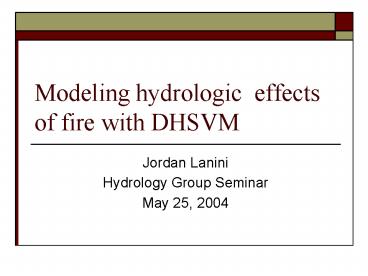Modeling hydrologic effects of fire with DHSVM PowerPoint PPT Presentation
1 / 27
Title: Modeling hydrologic effects of fire with DHSVM
1
Modeling hydrologic effects of fire with DHSVM
Jordan Lanini Hydrology Group Seminar May 25, 2004
2
Presentation Outline
- Motivation
- Background and literature review
- Modeling needs
- Potential solutions
- Model applications
3
Motivation
Photo from U.S. Geological Survey
4
Motivation
- Altered hydrological regime
- Increased sediment flows impact society and
ecosystems - Siltation of dams and structures
- Decreased transportation capacity in rivers
- Degradation of salmonid spawning habitat
- Increased nutrient transportation
- Management of forest resources
5
Background and literature review
6
Sediment Model
CHANNEL EROSION ROUTING
Provides Inputs for all Three Components
7
Increased runoff
- Decreased groundcover (lower leaf storage)
- Water repellency of soil (decreased infiltration
capacity)
8
Increased surface erosion
- higher raindrop impact energy
- Decreased groundcover
- higher overland flow detachment
- Increased runoff with higher transport capacity
- Water repellancy (Debano, 2000, Agee)
9
Increased mass wasting
- Decreased root cohesion
- Other factors- dry ravel, etc.
- Altered soil moisture state
- Increased pore pressures
- Decreased evapotranspiration
- Decreased infiltration in repellent zones
10
Modeling needs
11
Fire regime
- Spatial distribution of burn
- Spatial distribution of burn severity
12
Groundcover
- Severity of burn
- Percent groundcover remaining
- Type of groundcover remaining
- Vegetation recovery rates
- Succession sequence of vegetation
13
Water repellency
- Dependent on numerous factors
- Temperature of fire
- Severity of burn
- Soil type (Boyer and Dell, 1980)
- Vegetation type (more likely with resinous
conifers) - Hydrologic effects
- Modified infiltration rates
- Creates impermiable layer a short distance below
surface - During rainfall event, causes saturation of top
layer which is easily eroded
14
Tree characteristics
- Decreased root cohesion
- Decreased vegetation mass
15
Potential solutions
16
Fire regime prediction
- Use historical data within burned watershed?
- may find erosion rate data
- potentially have severity data
- Vegetation regeneration rates?
- data available (Los Alamos, Payette River, Storm
King Mtn., etc.) - Predict with outside model?
- adds additional error
- increases management applicability
- increases time spent learning new model
- Don?t predict, examine known event
17
Burn severity quantification
- Ground temperature (does data exist?)
- Existing classifications (Sources?)
- Vegetation cover following fire
18
Groundcover
- Based on severity class
- Aerial photos for recovery rates
19
Water repellency
- Distribute spatially based on
- veg. type
- soil type
- severity class
- Use literature ranges and model stochastically
with infiltration capacity - Top layer erosion modeling?
20
Root cohesion and vegetation weight
- Use literature relationship (Sidle, 1992)
- Sigmoidal cohesion increase
- Sigmoidal weight decrease
- Search literature far and wide for parameters
- Calibration parameter!
21
My current thoughts?
- Use historical data within burned watershed
(probably) - USFS burn severity and extent maps for Entiat
River (East side of Cascades) - Predict with outside model (maybe not)
- There are a lot of models out there?
- Not a lot of them do what I want
- Ones that do require knowledge of fuel, ignition,
etc. - Would have to combine three models
- FIRESTART for ignition
- FARSITE for intensity/spatial distribution
- Another for vegetation communities
- Data/computationally intensive
22
More current thoughts?
- Burn severity quantification
- Existing classification (USFS severity maps)
- Spatially distribute ignition and severity
probability over watershed - Good qualities of the Entiat River
- It?s gauged!
- Has been set up in DHSVM (VanShaar et al, 2002)
- Burns frequently
23
Model applications
24
Model applications
- Examine fire management strategies
- Would be difficult need severity, fuel
availability, etc - Examine climate effects
- Similar issues
- Predict sedimentation from recently burned
watershed
25
Please help me?
- Any feedback?
26
Errata
- Implementation outline and DHSVM code changes
necessary - Model Input
- Disturbance dates
- Disturbance extent
- Disturbance severity (Fire severity, logging
method) - Code changes
- INPUT.file
- MainDHSVM.c (test current datedisturbance date)
- Input map
- New function Disturbance.c (reads in extent of
disturbance) - Functions.h
- Data.h
- Parameter modification
- Create new veg/soil classes for each
disturbance/veg/soil combination - Recalculate parameters at specified time step (ie
monthly?) - Root cohesion
- Vegetation weight
- LAI
- Canopy height
27
References
- Agee JK, Fire Ecology of Pacific Northwest
Forests, Island Press, Washington, D.C., 1993. - Debano LF 2000. The role of fire and soil
heating on water repellency in wildland
environments a review. Elsevier Journal of
Hydrology, 231-232 195-206. - Doerr SH, Ferreira AJD, Walsh RPD, Shakesby RA,
Leighton-Boyce G, and COA Coelho 2003, Soil water
repellency as a potential parameter in
rainfall-runoff modeling experimental evidence
at point to catchment scales from Portugal.
Hydrological Processes, 17 363-377. - MacGregor DG 2002, An inventory of models, tools,
and computer applications for wildland fire
management. Riverside, CA USFS Pacific Southwest
Research Station. - McNabb DH and Swanson FJ 1990, Effects of fire on
soil erosion, from Natural and prescribed fire in
Pacific Northwest Forests, Walstad, JD,
Radosevich SR, and Sandberg DV, eds. Corvallis
Oregon State University Press. - Reid, L.M and T. Dunne, Rapid Evaluation of
Sediment Budgets, Catena Verlag, Germany, 1996. - Reinhardt ED, Keane RA, Brown JK 2001, Modeling
fire effects, International Journal of WIldland
Fire, 10 373-380. - Robichaud PR, Beyers JL, Neary DG 2000,
Evaluating the effectiveness of postfire
rehabilitation treatments. Gen. Tech. Rep.
RMRS-GTR-63. Fort Collins U.S. Department of
Agriculture, Forest Service, Rocky Mountain
Research Station. 85 p. - Sidle, RC 1992, A theoretical model of the
effects of timber harvesting on slope stability,
Water Resources Research 28(7) 1897-1910. - Wigmosta MS, Vail LW, Lettenmaier DP 1994, A
distributed hydrology-vegetation model for
complex terrain. Water Resources Research, 30(6)
1665-1679.

